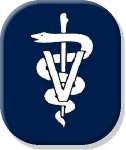
As mentioned in my previous post, I will now move onto my first of two Small Animal Internal Medicine rotations (a.k.a. The Block of Bad News). I need to first mention that the nickname is not my own brainchild, but rather that of the head technician with that service. She told us that the block is called that for a reason, and I learned that from the get-go.
On the very first day, I was transferred two cases from students from the rotation prior. One was being discharged at the end of the day, but was diagnosed with having a pheochromocytoma: a potentially nasty tumor of the adrenal glands, but particularly of the cells that produce epinephrine and other similar hormones. The other case was a really sweet Springer Spaniel who had end-stage chronic liver failure. Just looking at the dog gave away that its liver was in trouble. All of its membranes were a yellow color, which you may have heard refered to as being "jaundiced". The reason this happens is that when red blood cells are normally broken down in the body, they release their hemoglobin (the oxygen carrying molecule, picture above) which is converted in the blood to a compound called "bilirubin". Normally, it's the liver's job to take in all the excess bilirubin in the body, process it, and send it to the gall bladder to help make up "bile". However, when the liver has been mostly destroyed, it cannot take in the bilirubin, which builds up in the blood and causes the yellow discoloration throughout the body. In addition, the dog had a tremendously large "pod-bellied" appearance. Another one of the liver's jobs is to create albumin, the most abundant protein in the blood. While it has numerous functions, one of the most important ones is to provide an oncotic pressure gradient to keep water in the blood stream. When the liver is failing and there isn't enough albumin, water leaks out of the blood and into body cavities like the abdomen.
It was a particularly sad case because the dog was only 5 years old and the reason it had the liver failure was from the treatment it was receiving for its epilepsy. The first drug that vets reach for when treating a dog with epileptic seizures is phenobarbital. While it often helps reduce the frequency of the seizures, it can be highly toxic when blood levels reach above a certain threshold. Therefore, dogs chronically receiving the drug need to visit their vet regularly to get their blood level of the drug measured for that reason. This dog was receiving the correct amount of drug and was having his phenobarbital level measured at correct intervals with the level never breaching that threshold. This is a case of an "idiosyncratic" reaction where adverse effects occur even when following set guidelines. While they are very rare, they are devastating for both the veterinarian and the owners.
Needless to say, these two cases left me helpless and confused. While the first case was coming back in a week to get the pheochromocytoma removed, the latter case was basically sent home to die. This was a drastic change of pace for me since my first ever set of cases was on orthopedic surgery where all the patients who come in are otherwise healthy and stable besides their torn ligaments, bad hips, etc (except for the hit-by-cars and fractured bone patients). The liver failure case had the "book thrown at him" in that every possible treatment was attempted in order to help him. Sadly, liver disease is exceptionally frustrating to treat, both in animals and in people. Therefore, if you are reading this, consider this a good reason to treat your liver well and not drink excessively :P.
Stay tuned for next time as I detail the story of my most involved and difficult case I've seen thus far in veterinary school!


